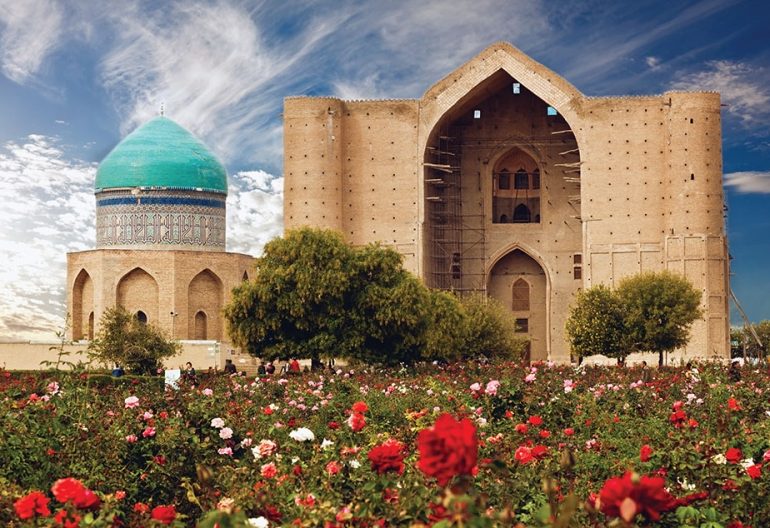The Republic of Kazakhstan is a country where local heritage is key to the cultural code. Beyond that, the ninth-largest country on the planet is considered the heir to cultures and civilizations that make scientists and archeologists rewrite history books with each new excavation.
CULTURAL PROPERTY
There are three Kazakh UNESCO World Heritage sites included on the list on the basis of their cultural heritage.
• The Mausoleum of Khawaja Ahmed Yasawi (2003)
A table-tomb, lifted over the grave of the poet and preacher Khawaja Ahmed Yasawi, is situated in the ancient town of Turkestan in the South Kazakhstan Region. The complex is the central landmark at the historical and cultural reserve museum.
The modern museum was constructed on the grave of the Sufi poet, who had a sizeable following among the Muslims of this region, and had an important impact on the development of Islam in Central Asia in general. He died in 1166 and was buried with great honors in a small mausoleum. The mausoleum that now houses his remains was built 233 years after his death, on the orders of the Turkic military leader and conqueror Tamerlane. In 1395 Tamerlane beat the ruler of the Golden Horde, Tokhtamysh, and burnt down his capital, Saray-Berke. In honor of this victory, Tamerlane decided to build a new monumental memorial complex on the site of the old one.
The mausoleum is considered a primary example of ancient architecture. Many of the techniques used for its construction—the building does not contain a single nail—remain a mystery even in the 21st century. The building itself is acknowledged as a masterpiece of human genius, and its unique mosaic is regarded as an exceptional example of ancient craftsmanship.
• The Tamgaly petroglyphs (2004)
Tamgaly is an archeological site located in the Anrakay Mountains, 170 km northwest of Almaty. This is one of the oldest and most impressive examples of rock carving in Semirechye, a geographic area of Central Asia. This unique valley, which was the cradle of many steppe civilizations, is also home to a temple with many petroglyphic drawings, which was discovered in the 1950s.
The total number of rock carvings in the main canyon is around 2,000. All of them can be nominally classified into seven groups: engravings of sun-headed gods, masks, warriors carrying clubs, wedded couples, women in labor, hunting scenes and oxen sacrifices. Images of chariots are rare. Archeologists often focus on the numerous solar representations.
The majority of the petroglyphs date from the Bronze Age. The carvings in the animalistic Saka style are mostly located separately from more ancient petroglyphs, but in some cases they supplement or even cover them. Medieval petroglyphs are carved into the surrounding bald peaks. The central complex distinguishes itself with the densest concentration of petroglyphs and what some claim are altars, supporting theories of this place’s ceremonial use.
• The Silk Road sites of the Chang’an-Tianshan Corridor (2014)
During the 38th session of the UNESCO World Heritage Committee, a landmark decision was made to add not only the Silk Road itself to the list, but also the majority of the ancient settlements which appeared nearby.
In addition to sites in China and Kyrgyzstan, eight Kazakhstani spots were included on the extensive list of cities that flourished beside the Silk Road: Kayalyk, Karamergen, Talgar, Aktobe, Akyrtas, Kulan, Kostobe and Ornek. All of them are situated in two areas of Kazakhstan, the Almaty and Zhambyl Regions. According to archeological research, Karamergen is the biggest and northernmost medieval city from the agricultural civilization that emerged between the 12th and 13th centuries in the Ili River Delta. Akyrtas, according to one theory, is either a Buddhist temple or a castle complex.
BEAUTY OF NATURE
A significant part of the UNESCO World Heritage List is made up of natural areas, the preservation of which is an important mission for humanity. There are two nature reserves in Kazakhstan which have already been recognized by this list, and six more areas have been nominated for this category.
• Saryarka – steppes and lakes of Northern Kazakhstan (2008)
This is the very first “biosphere reserve” on the World Heritage List in Kazakhstan and Central Asia. This natural area consists of two national reserves located on the steppe, Korgaldzhyn and Naurzum, which together have a total area of 450,344 ha.
The nature reserve includes two groups of lakes with fresh and salty water, situated at the Continental Divide between the rivers flowing to north to the Arctic, and those going south to the Aral Sea. This area is ecologically important because it contains the most popular resting points for the millions of birds which regularly migrate from Africa, India and southern Europe to their breeding grounds in western and eastern Siberia. These wetlands support populations of endangered species, such as the white crane, greater flamingo and white-tailed eagle. 200,000 ha of distinctive, untouched Central Asian steppe constitutes part of the site, and is a habitat for more than half of the regional steppe flora, as well as the Saiga antelope.
• Western Tian Shan (2016)
Including this huge geographic zone on its list was one more step UNESCO made to acknowledge unique natural areas as part of humanity’s shared heritage. Uzbekistan and Kyrgyzstan are responsible to future generations for preserving the flora and fauna of this mountainous reserve along Kazakhstan’s southern border.
Kazakhstan demonstrated its intention to protect this area by establishing two nature reserves and one national park. The Aksu-Zhabagly Nature Reserve was founded as early as 1926, and is the only place where the famous Tulipa Greigii naturally grows. In the Karatau Nature Reserve one can find the Red Book listed Indian crested porcupine. The Sayram-Ugam National Park is the most exceptional in the country: seven natural zones, from steppe to high mountains, are located there.
Environmentalists believe that Kazakhstani authorities were able to protect the snow leopard population in Tian Shan due to the special status of these nature reserves.














